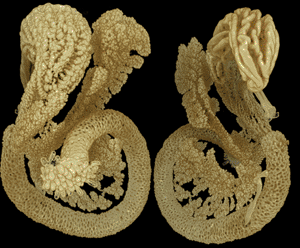Optical Projection Tomography Reveals the Pancreas as Never Seen Before
By MedImaging International staff writers
Posted on 12 Sep 2011
Swedish scientists helped by optical projection tomography (OPT) described aspects of how the pancreas develops during embryonic development and how the islets of Langerhans are distributed in the adult organ. The findings are important for the interpretation of modeling systems for diabetes.Posted on 12 Sep 2011
New methods for OPT imaging technology are presented by Prof. Ulf Ahlgren and associates at Umeå University (Sweden) and colleagues online July 14, 2011, in the journal IEEE Transactions on Medical Imaging. Using these techniques, the researchers have also made new discoveries about the developmental biology and adult structure of the pancreas. These findings were published online on June 30, 2011, in the journal PLoS ONE and the July/August 2011 issue of the journal Islets.

Image: OPT images depicting two views of the embryonic stomach, intestine, and pancreas of a mouse. The newly developed algorithms presented in IEEE Transactions on Medical Imaging allow OPT imaging of biomedical preparations in great detail. The study was performed in collaboration with researchers at the Centre for Genomic Regulation in Barcelona, Spain, as well as the Department of Computer Science at Umeå University and Umeå Center for Molecular Medicine (UCMM). The two images depict the same preparation; the image on the right is rotated 180 degrees (Photo courtesy of Prof. Ulf Ahlgren et al. Umeå Center for Molecular Medicine).
OPT is a technique for three-dimensional (3D) visualization of gene and protein expression in tissue samples. The technology, very similar to medical computed tomography (CT), uses ordinary light instead of X-rays and it is being used more frequently in basic research fields such as developmental biology, plant biology, and pathology. OPT, which was originally limited to analyses of small compounds, has previously been refined by the Umeå scientists to enable analysis of entire organs, such as the pancreas from various rodent model systems to understand diabetes.
In the study presented in IEEE Transactions on Medical Imaging, the researchers described a computer-based technique for correcting distortions in the creation of OPT images. The newly developed technology contributes generally to enhanced quantitative and visual OPT analyses in various types of tissues by increasing the sensitivity to small and faintly illuminated objects and by creating a more exact reproduction of the cells depicted in the tissue.
In one of the studies, published in the journal PLoS ONE, the researchers described the developmental biologic conditions for the formation of the so-called gastric lobe of the pancreas in the embryo. The development of this part of the pancreas has not been described in detail. However, the Umeå scientists have found that this part of the pancreas is dependent on the normal development of the nearby spleen in order to form.
In yet another study, published in the July/August 2011 issue of the journal Islets, the researchers revealed that the insulin-producing islets are more numerous and significantly more unevenly distributed in the pancreas than was previously thought. For instance, the gastric lobe of the pancreas contains relatively more islets of Langerhans than the rest of the organ does.
Taken together, these studies offer information that is valuable to help assess how hereditary and environmental factors affect the number of insulin-producing cells in various model systems for diabetes.
Related Links:
Umeå University














